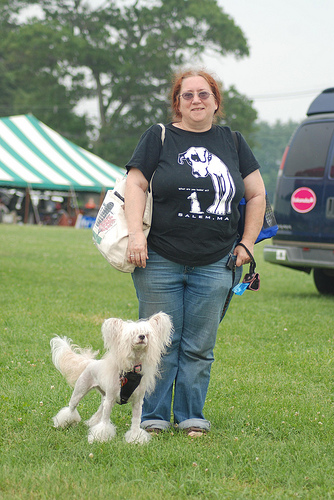
by Karen Delise
Previously I reviewed Dogs Bite, But Balloons and Slippers are More Dangerous, which looked at the risk from dogs in general and pit bulls in particular from a statistical viewpoint, revealing that despite media hysteria, dogs are among the safest features of our daily lives. The Pit Bull Placebo looks at the question from the other direction—the history of dog attacks and the reporting of them in America over the last two centuries. In the process Delise finds major changes over that time both in what dogs are considered “dangerous,” and in how dog attacks have been described and explained.
For much of the nineteenth century, the “dangerous dog” was the bloodhound—including, but not limited to, St. Hubert’s Bloodhound, the dog that became the basis of breed we now recognize as the bloodhound. In addition to these dogs, a wide variety of other breeds and mixes were loosely classed as “bloodhounds,” based primarily on function: they were primarily use to track fugitives, including criminals but also escaped slaves before the Civil War, and escaped prisoners of war during it. Horrifically scary stories of the savagery of bloodhounds circulated widely, even while bloodhound enthusiasts wrote passionately about gentle, noble character of their dogs.
Why the split view? The difference was primarily the intent and behavior of the owners or handlers. People who went to the trouble and expense of acquiring the relatively uncommon St. Hubert’s Bloodhound, or mixes thereof, were usually people who valued their dogs, trained them, housed them indoors with the family, and encouraged their tracking behavior, but did not incite violence towards the quarry. Those who bought “Cuban,” “Florida,” or “Texas” bloodhounds, or mixes thereof, usually had very different intentions and treated their dogs differently. They wanted their dogs to be dangerous, kept them outside on chains, often abused them, and encouraged violence towards the quarry, when caught. Yet all these dogs were called “bloodhounds,” and responsible owners with carefully trained and cared-for dogs had to contend with the reputation created by irresponsible and often thuggish owners.
This will be a familiar tale to any pit bull enthusiasts, who today contend with an image created by lumping together a variety of breeds and any mixes thereof under the label “pit bull,” and then emphasizing the scary stories generated by the irresponsible behavior of substandard owners, who want “pit bulls” because they want dangerous dogs—and the “pit bull” is the current popular “dangerous dog.”
Delise goes on to describe how the “dangerous breed” label moved from breed to breed over the decades, with breeds as disparate as Newfoundlands and Dobermans getting the label based solely on the breeds’ changing popularity as guard dogs.
But this isn’t solely about the changing identification of this breed or that breed as “dangerous.” It’s also about changes in how dog attacks are reported and described in the news media. Throughout the nineteenth century, newspaper accounts routinely emphasized owner behavior (abuse of the dog), purpose of the dog (guard or protection dog), living conditions (dog chained or confined to the yard, dog newly acquired, etc.), and victim behavior (teasing the dog, entering property the dog was guarding, etc.) News stories would mention that the weather was oppressively hot and that would naturally “make the dog irritable.” Or that a child had tried to take a bone or other high-value item from the dog, or tried to separate two fighting dogs. Dog breed was included, but it wasn’t offered as an explanation, and dogs were assumed to be and were described as emotional beings, who would react emotionally to events in ways that made sense from a dog’s perspective. This doesn’t mean that fatal attacks were excused; they weren’t, and dogs were routinely destroyed. However, despite the pragmatic elimination of the attacking dog, the attacks were not treated as incomprehensible or the product of a particular, uncontrollably dangerous breed.
As the twentieth century progressed, newspapers stopped describing dogs in emotional terms, but continued to describe the circumstances of dog attacks. Use as a guard or protection dog, confinement to the back yard or the end of a tether, and similar factors continued to be the major risk factors for a severe or fatal dog attack.
Then, in the 1980s, just when the pit bull was becoming the new popular “dangerous dog,” news media stopped describing the dog’s purpose, living conditions, or events leading up to the attack, and instead simply reported the breed. Apparently, over the decade of the 1970s, children stopped teasing dogs, thugs stopped wanting dangerous dogs, people stopped buying “guard dogs” and leaving them confined to the back yard or to the end of a chain. And at the same time, dogs changed from loyal, patient, tolerant, people-loving animals into unpredictable super-predators.
Or, those major changes in human and canine nature did not occur, but only the reporting of and popular ideas about dog attacks changed. I think we innately know which is more likely, and Ms. Delise lays out the evidence in well-researched, well-argued prose.
Of special note are the appendices, which include very informative discussions of how Denver, CO came to enact its pit bull ban, and the effects that that ban has had.
Highly recommended.
I downloaded The Pit Bull Placebo in PDF format at no charge from the website of the National Canine Research Council. You can also purchase a paperback edition of this book from Amazon.
Reviewer Bio:

Lis and Addy
Lis Carey is a librarian with an odd sense of humor, who finds excitement in helping people find the information they need, and in the varied corners of library work--reference, cataloging, circulation, resource development, reader's advisory. She reads voraciously and enjoys a wide variety of material--including, of course, fiction and non-fiction about dogs and cats. Addy, her Chinese Crested, is always happy to keep her company while reading, and occasionally tries to help write the reviews.
Check out her Blog Lis Carey's Library for more Book Reviews.